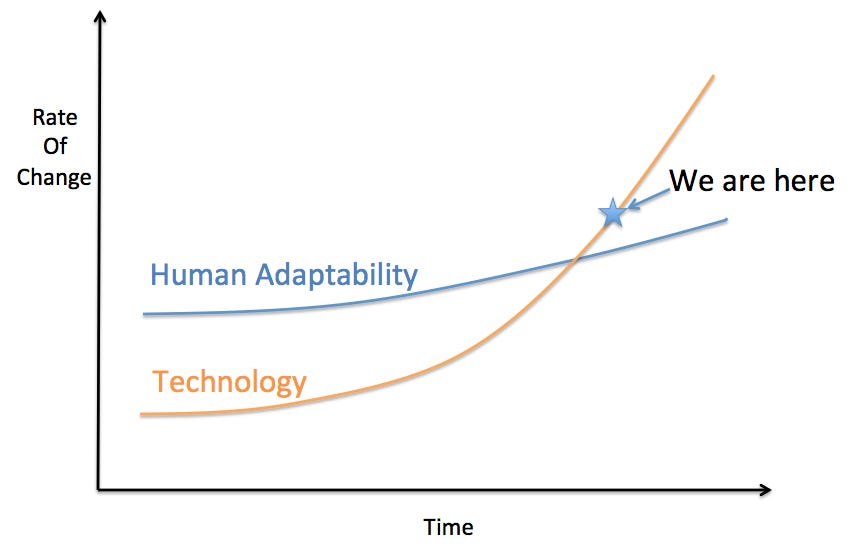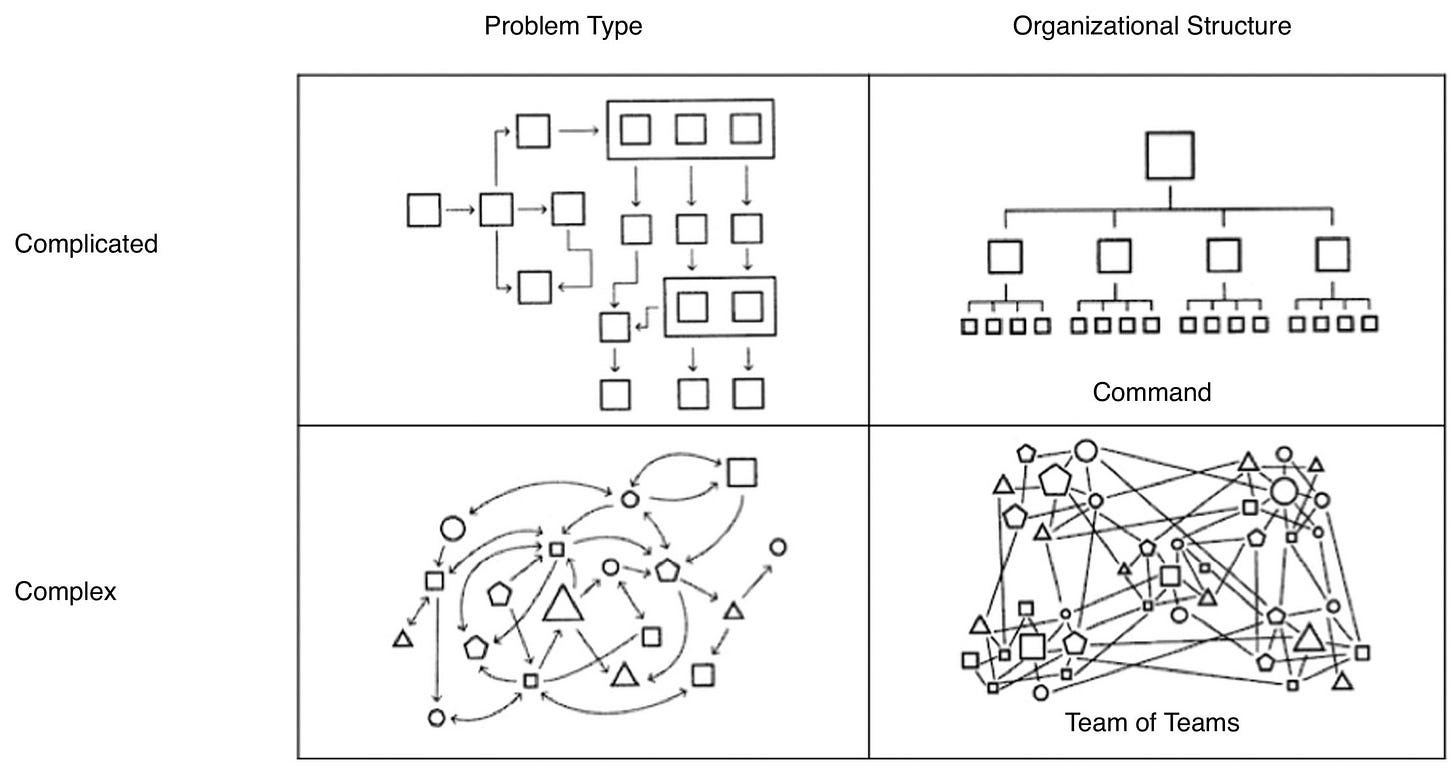In the 21st century, when change is the only constant, understanding and managing complexity has become not just a skill but a necessity.
If you were born in America in the 1940s, you have had a front-row seat to one of the most dramatic transformations of our collective culture and lives. I have spent much time in this Substack arguing that our most pressing problems come from our environment of too much. And, to be sure, this rate of change might be too much.
What tools do we have for managing our lives and work in such a complex environment? Do we have any at our disposal up to this monumental task? The first step is to understand the environment we are in — which is not just complicated, it is complex.
NYU Professor of Pathology Neil Theise’s short yet fascinating book on Complexity Theory entitled Notes on Complexity offers a framework for grappling with being alive today. Complexity Theory addresses the mysteries that animate science, philosophy, and metaphysics.
So let’s define the terms.
A complicated system is characterized by its many parts and the intricate way these parts interact, but crucially, it operates under a set of knowable rules and principles.
But in a complex system, the dynamic interactions of its components can adapt or change based on their history and context. These systems are marked by unpredictability and non-linearity, where small inputs can lead to disproportionately large outputs—or, conversely, significant inputs may have minimal effects. Complex systems exhibit emergent properties, meaning the system as a whole can exhibit characteristics and behaviors that its individual components do not. Examples of complex systems include ecosystems, the human brain, and social networks.
The main ideas of complexity are:
The whole is unpredictably greater than the sum of its parts (kind of like the world, kind of like our lives).
Even if we knew all the variables, we cannot predict emergent properties.
It is an attempt to understand how parts combine with each other — self-organizing to make a whole.
Theise uses the interactions of ants to illustrate the fundamentals of complexity in action. Because as the ants go, so goes the rest of us. Here are the rules of complexity that govern ants and us:
Numbers Matter
A complex system must have a certain number of interacting parts. The minimum number of ants is about 25. With 25, you get tunnels and food lines, and the ants even build cemeteries for their dead. However, when the number of interacting parts falls too low, the self-organization and emergent properties stop developing.
The reverse is also true — the more participants in the system, the more complexity there is.
Interactions are Local, not Global
With ants, there is no central leader or group of leaders calling the shots (the queen only serves a reproductive function). The colony's organization develops organically through local interactions between the participants.
Using pheromones as a guide, the ants communicate with one another.
In a human organizational system, we might think that some systems are top-down (think authoritarian leaders), but we are mistaken. The leader is always a part of the system or the web of interactions.
“Ultimately, leaders won’t know about the whispering among the gathering insurgents, whose burgeoning revolution, itself an emergent phenomenon, will potentially rise up and overthrow the attempted top-down leadership. Thus the belief of authoritarians that they monitor every detail of the system as a whole is revealed as an illusion.”
In our own bodies, we tend to think of the brain as the authoritarian in the system, but again we are mistaken. There is no single cell or organ governing our body as a whole, instead our brain communicates with other parts of the body via nerves — resulting in feedback that goes both directions. The adrenals and our gut or digestive system are examples of different parts of the body that also inform the brain. The brain is also part of the web — “being acted upon even as it exerts its influence.”
“So, who is in charge of whom?” According to Theise, “Ultimately, no one ever is; all interactions are local. Every element of a complex system interacts with every other element through networks made up of local connections. Some elements have greater or lesser influence, but none are truly above and beyond the web; none reach down into it from outside with inexorable intent, exerting total control.”
Negative Feedback Loops Prevail
Like our bodies, our complex systems want to maintain homeostasis for survival.
Homeostasis is any self-regulating process by which biological systems tend to maintain stability while adjusting to optimal conditions for survival. If homeostasis is successful, life continues; if unsuccessful, disaster or death ensues.
Importantly, the stability attained is actually a dynamic equilibrium in which continuous change occurs, yet relatively uniform conditions prevail.
When a system is disturbed, built-in regulatory devices respond to the departures to establish a new balance; through feedback control.
To understand how a feedback loop works, a common example is an air conditioning unit. The unit detects the temperature in a room—it turns on if the room is too warm and turns off when the room returns to the desired state. This is an example of a negative feedback loop. In the reverse, if the air conditioning unit were using a positive feedback loop, the increase in room temperature would result in a heating element being turned on, making the room hotter.
“Negative feedback loops previal in complex systems, keeping a system’s conditions within an oscillating, healthly, homestatic range. In homeostasis, the system sustains the capacity for adaptation to the changing world around it, preventing any one member of the system from overwhelming others.
….
If positive feedback loops overtake the balancing negative ones, then the self-sustaining homestatic equilibrium gives way. Energy-expending behaviors come to predominate, ultimately crashing and burnings the system. Think economic bubbles or cancer. Both arise out of a preexisting homestatic living system — a well-fucntioning economy, a healthy body made of interacting cells — yet for reason particualar to each, negative feedback declines, allowing positive feedback to predominate. Explosive growth ensues, following by utter collapse: recessions or depressions in economies; death in the case of those with terminal cancer.”
The Degree of Randomness is Key
Not too much, not too little.
“Too much randomness prevents any self-organization at all, while too little randomness causes a system to behave more like a machine, without enough flexibility to find new modes of adaptive behaviors.”
The defining feature of a complex system is unpredictability, which is the source of its creativity. In a healthy system, there is always the possibility of divergence—like the ant that doesn’t follow the food line and discovers the next food source. This ant isn’t lost—the system is designed for some divergence, which ultimately becomes the source of adaptation.
When you have the right amount of randomness, new possibilities emerge. A small amount of randomness keeps the system alive.
This slight randomness fuels biological creativity, allowing life to generate various responses to environmental shifts. This process can result in the emergence of new species or types of ecosystems.
Nothing Lasts Forever
One of the wise, sad truths of existence—maybe the most fundamental—is that what makes us alive also demands that we die.
“Complexity — information-rich, lifelike systems—erupts at the phase transition where chaos and stability pull in opposite directions.”
- Roger Lewin
When randomness takes us to the boundary where chaos and stability pull in opposite directions, we sometimes end up in places that we wish were different. Instead of finding the divergent path for sustaining life, “we might be let out of it, either into rigid, machinelike determinism or into chaos. Either way, the tug-of-war resolves, the self-sustaining, adaptive creativity of the system is lost, and it will undergo a partial or complete mass extinction event.”
While this might sound like a huge bummer, from a macro level, we can find some comfort.
“Without the extinction of dinosaurs, would mammals have risen to prominense? Without the Black Death in Europe, would there have been a Renaissance? Death clears the way for more extraordinary, unpredictable life. And is’t there more to life that just staying alive? What about the meaning of being a part of a larger, ever-evoling whole? And just like that, the abstractions of complexity theory — numbers, geometrics, computational models — begin to brim with questions of fate, meaning, life and death.”
Keep looking for connection,
Recommendations:
What I am Reading:
The Experience Machine by Andy Clark
Just came in the mail — The Anxious Generation: How the Great Rewiring of Childhood Is Causing an Epidemic of Mental Illness by Johnathan Haidt
What I am listening to:
Angela Duckworth on Armchair Expert
The Podcast Theme is Out: How Does Change Happen?
Thwarting Hedonic Adaptation
I recently started taking the course the Science of Well-Being with Professor Laurie Santos. Santos launched the class in the spring semester of 2018 as an early observer of the American mental health crisis (now shown throughout the Anglosphere). Santos was concerned about the data she was seeing and the diminished well-being of her students, so she wo…
Rewirements
I’m in Week 7 of the Science of Well-Being — and so far, we have covered all the ways the mind leads us astray or gives us the wrong ideas about what will provide us with a satisfying and purpose-filled life. We have since moved on to the strategies we can use to train our minds to see and appreciate the right things — the habits that positively contrib…








